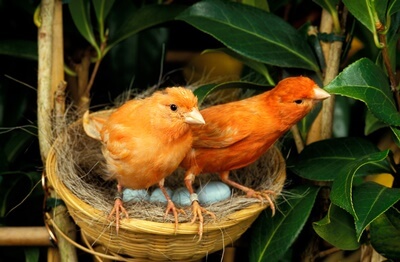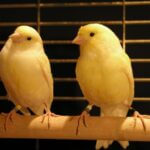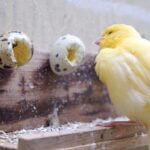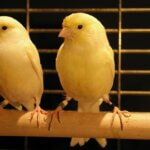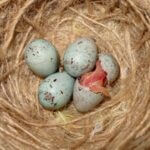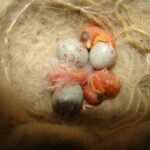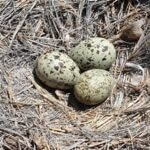Canaries kept as pets aren’t usually intended for breeding. Regardless, sexually mature female birds can lay eggs. So, you may be shocked to discover that your canary has laid eggs without a male.
Female canaries can lay eggs without mating. Fertilization occurs while eggs are still in the cloaca, but if no male fertilizes the eggs, the female will lay unfertilized eggs. In most cases, a female canary will produce 3-5 eggs per clutch and lay 1 egg per day until the clutch has been completed.
You can tell when a canary is getting ready to lay eggs based on certain physical and behavioral signs. If you don’t want to breed your canary, create a living environment that prevents nesting cycles, as non-fruitful nesting and egg-laying can be stressful and lead to egg-binding.
Can Canaries Lay Eggs Without a Male?
Canaries don’t have a set breeding season. However, the conditions which make it easiest for them to breed are found in spring, between March and July.
Therefore, if you keep your female canary in the right conditions, she’ll develop and lay eggs. This applies even if there’s no male present to fertilize the clutch.
The required conditions for canary breeding can differ based on whether the birds are kept in an aviary or a cage. However, canaries prepare to breed when the following factors apply:
- Sufficient daylight (at least 8-10 hours per day)
- Warm, optimal temperatures
- Availability of high fat, protein, and calcium-rich foods
- Canary is sexually mature
- Suitable nesting material is available
Female canaries will exhibit nesting and mating readiness behaviors when these conditions are met.
Do Canaries Lay Unfertilized Eggs?
If your canary has laid unfertilized eggs, her behavior may change for 20-30 days. She may incubate her eggs, refuse to eat or consume less food, and become opposed to being handled.
According to Integrative and Comparative Biology, prolonged periods of dietary restriction in canaries can alter how they deal with stress, especially if they’re young.
The long-term impact on sexually mature canaries is likely less severe, as they have stronger immune systems and greater stress tolerance.
If you have a pair of canaries and are uncertain whether the laid eggs are fertile, remove them from the nest to check them. When you do this, replace the egg with a fake egg.
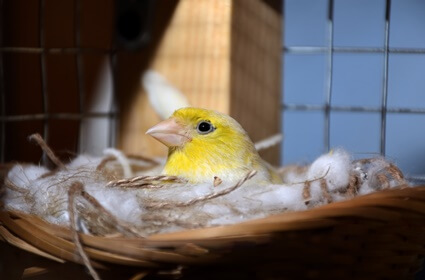
How To Tell If Canary Eggs Are Fertile
If you have a pair of opposite-sex canaries, they’re likely to breed and produce fertilized eggs.
However, there are many cases where owners won’t know they have a breeding pair due to mis-sexed canaries. Rather than pairing two females, an owner may pair up a male and a female.
If your female has laid eggs and you’re unsure whether they’re fertile, there are ways to check. This is important because leaving unfertilized eggs in an otherwise fertile nest can drain a female’s energy, and it also presents a risk to fertile eggs due to decay.
The easiest and most reliable way to tell if an egg is fertile is the traditional process known as ‘candling.’ Here, an egg is held above an intense light to show whether there’s an embryo inside.
Wait up to 5 days after an egg has been laid before checking. An egg can be safely removed from a nest for up to 10 minutes, but it’s better to act quickly.
Set up an intense, cool light source to avoid drastically altering the egg’s temperature.
If the canary eggs are fertile, you’ll see a dark spot with visible blood vessels inside the egg. These are signs that there’s a viable, growing embryo. If you want this embryo to grow further, you must quickly return it to the nest.
Once you’ve done this, you should allow your canary to follow its instincts and incubate any fertile eggs unless you do not wish them to hatch.
How Often Do Canaries Lay Unfertilized Eggs?
There’s no defined ‘breeding season,’ as mentioned. This means that canaries can, and often do, produce eggs throughout the year.
A female can reach sexual maturity at 3-6 months of age. In the right conditions, she may produce fertilized or unfertilized eggs for most of the year, except for intense nesting cycles, when she may produce one egg per day.
Canaries are polygynous breeders. According to Ethology, this means that a male may mate with many females, but females will choose a single mate based on the following:
- Song
- Appearance
- Territory
Females will incubate fertilized eggs for around 13 days until they hatch. However, she may sit on unfertilized eggs for 30 days before losing interest.
If you don’t intend to breed your canary, create conditions discouraging egg creation and laying.
Should I Remove Unfertilized Canary Eggs?
If there are several infertile eggs in a clutch of fertilized eggs, you should remove them. This will reduce the burden on the female, as she likely doesn’t realize that the eggs won’t develop.
However, it may not be necessary if your canary has laid a full clutch of infertile eggs. You can remove these eggs and replace them with fake eggs.
This will protect your canary’s health while allowing it to naturally lose interest in the infertile clutch.
How To Discourage Egg-Laying in Canaries
If your canary has laid unfertilized eggs and you wish to discourage this in the future, change her diet and sleep schedule. Ensure that your canary gets 12-14 hours of uninterrupted sleep in a dark environment.
Avoid a diet rich in fat or warm, soft foods that stimulate regurgitation. This is what birds use to feed babies and incubate mates.
Instead, offer your canary a diet rich in leafy greens and vegetables. Supplement this with high-quality pellets and grains to ensure proper nutrition. This will ensure your canary remains healthy but doesn’t get the hormonal urge to develop eggs.
Don’t provide a ready supply of nesting material. This can be difficult, so you may need to re-arrange the cage occasionally to act as a distraction. Otherwise, a female canary may shred bedding, toys, and leafy foods to serve as nesting material.

